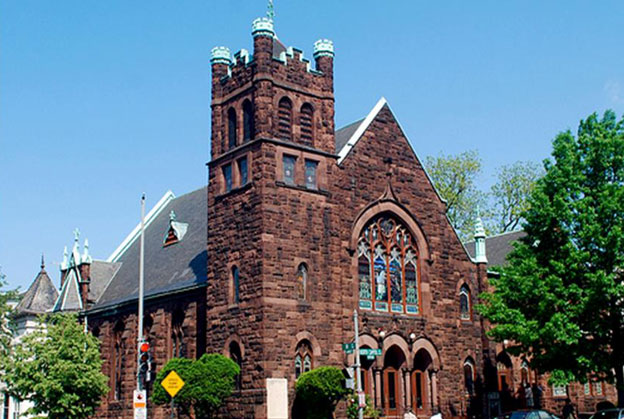





 Metropolitan Wesley African Methodist Episcopal Zion Church, founded in 1832, served as a station on the famed “Underground Railroad”, is the birthplace of the first Public School for Washington’s African-American children, and is the “Mother Church” of the witness of the African Methodist Episcopal Zion Church in the nation’s capitol.
Metropolitan Wesley African Methodist Episcopal Zion Church, founded in 1832, served as a station on the famed “Underground Railroad”, is the birthplace of the first Public School for Washington’s African-American children, and is the “Mother Church” of the witness of the African Methodist Episcopal Zion Church in the nation’s capitol.
In 1729, a small group of students at Oxford University in England formed a Holy Club, to “win fellow students to a studious and virtuous life and to obtain a thorough knowledge of the Scriptures in the original tongues.” The best known members of this club were John and Charles Wesley. Wesley taught a process of sanctification, to love God with all one’s heart, mind, soul and strength, and to love one’s neighbor as oneself. Holiness of heart had to find fruit in outward works and social involvement. By 1739, Wesley and others were preaching to huge, open-air meetings.
In 1739, Wesley was asked by eight or ten people to spend some time with them in prayer and discussion, which began the Methodist system of class meetings. When the people of this movement, who were changed by it, were not acceptable to the established church, the Methodist Church was the result. “Methodism is Christianity in earnest” Wesley said. “A Methodist is one who lives according to the method laid down in the Bible.” Methodism in America Methodist practice of the Christian faith arrived in North America as part of the “Great Awakening,” an evangelical movement that swept the English-speaking parts of the world in the middle of the 1700’s. This movement also produced a great surge in the Baptist church, and missionary work by “New Light” Presbyterians. Evangelists found immediate acceptance among craftsmen, servants, slaves, apprentices, bondsmen and small farmers. It was a fundamental principle of Methodism that all men are equal in the sight of God. A.M.E. Zion Bishop James Walker Hood wrote, on the church’s 100th anniversary in 1896, “At the birth of Methodism in this country, they thought not of the complexion of the attendants, but rather of the salvation of their souls.”
Methodism was first introduced into North Carolina in 1790 by Henry Evans, a minister of African descent. The church Evans founded was taken into the A.M.E. Zion denomination in 1866. In 1774, John Wesley wrote Thoughts Upon Slavery, a pamphlet which described the people of west Africa as “a sensible and ingenious people, kind and friendly, courteous and obliging, and remarkably fair and just in their dealings.” Six days before his death in 1791, Wesley wrote to William Wilberforce, a leader in the the British movement to abolish the slave trade “if God be for you, who can be against you? Are all of them stronger than God? O be not weary of well doing! Go on, in the name of God in the power of His might, till even American slavery (the vilest that ever saw the sun) shall vanish away before it.”
Source: Judah Temple AME Zion – A Brief History of the African Methodist Episcopal Zion Church by John Wesley
Through a 25 year period of separation, a close relationship continued with the Methodist-Episcopal Church.” In 1795, Bishop Asbury met with 8 classes made up of 155 members of African descent. In 1806 Bishop Asbury ordained James Varick, and two other preachers. This had been authorized by a Methodist-Episcopal conference in 1800, but that raised so much opposition it was not acted on. Leaders of the A.M.E. (Zion) church voted to remove themselves entirely from the Methodist-Episcopal Church in 1820, and published their first discipline as an independent church. But in 1822, church leaders were ordained as elders, by elders of the Methodist-Episcopal Church. Varick soon after became the church’s first bishop. During this period there were also discussions with Richard Allen, the first Bishop of the A.M.E. (Bethel) Church in Philadelphia. The obvious way to go would have been “We’re the A.M.E. church in New York, we’re the A.M.E. church in Philadelphia, and we will be joined by other A.M.E. churches in other places.” That never happened. There have been numerous attempts to unite, which have never been consummated.
Although various Methodist denominations remain far apart organizationally, all belong to the World Methodist Council. The African Methodist Episcopal Zion Church has participated since 1881. As for the AME Zion denomination, “Our heritage is African, though our membership is open to all who desire salvation through Jesus Christ; Our tradition is Methodist – establishing our order of service, administration and conduct; Our government, supervision and leadership structure is Episcopal – our leaders are called Bishops; and, Our foundation is ‘Zion’ referencing the name of the first church and the Holy City we all press toward as our eternal home.”